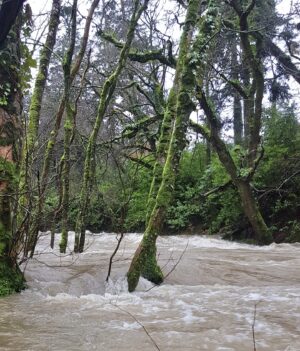Trees with Their Toes in the Water: Alder, Willow, and Bald Cypress

Not all trees thrive in wet ground, but some species have adapted remarkably well to life with their roots submerged or in saturated soil. Among the best known are alder (Alnus), willow (Salix), and bald cypress (Taxodium distichum). Each plays a key role in stabilizing waterways, reproducing in wet conditions, and providing ecological benefits that extend to both humans and wildlife.
Bank Stabilization
Waterways are naturally dynamic systems, with banks that can shift and erode over time. Trees such as alder and willow are crucial in holding these banks together. Alders develop dense root systems that grip soil tightly, reducing erosion along rivers and streams. Similarly, willows have long, fibrous roots that spread widely and bind soil particles, acting almost like a living net. Bald cypress trees are less common along fast-moving rivers but dominate in swamps and floodplains. Their root systems, which include distinctive “knees” that protrude above water, help anchor them in soft, shifting sediments. In each case, the presence of these trees prevents soil loss and maintains more stable aquatic habitats.
Reproduction Through Water
These species have also adapted to use water as a mechanism for reproduction. Willows are particularly effective at vegetative reproduction: broken branches can float downstream, take root in wet ground, and grow into new trees. Alders disperse lightweight seeds that are carried by water, enabling them to colonize new wet areas quickly. Bald cypress trees produce woody cones that release seeds into standing water, where they can establish when conditions are right. These strategies ensure that populations remain resilient in environments that frequently flood or shift.
Benefits of Water-Resistant Trees
Water-tolerant trees provide numerous benefits to ecosystems and people. By stabilizing soil, they reduce sediment entering rivers, which improves water quality. They also mitigate flood impacts: dense stands of willow or cypress can slow water flow, reducing the severity of downstream flooding. Their shade lowers water temperature, which benefits aquatic species such as trout and amphibians. In addition, these trees contribute to biodiversity by offering habitat and food for insects, birds, and mammals.
For human communities, the presence of water-resistant trees translates into natural flood control, cleaner waterways, and protection of infrastructure built near rivers and wetlands. In a time of increasing climate variability, species that withstand flooding are especially valuable as buffers against extreme weather events.
Conclusion
Alder, willow, and bald cypress are excellent examples of trees that thrive with their “toes in the water.” They stabilize banks, reproduce effectively in wet habitats, and deliver ecological services that benefit both nature and people. Preserving and planting these species where appropriate is an important step in maintaining resilient waterways and healthy ecosystems.
Comments are closed for this post.
